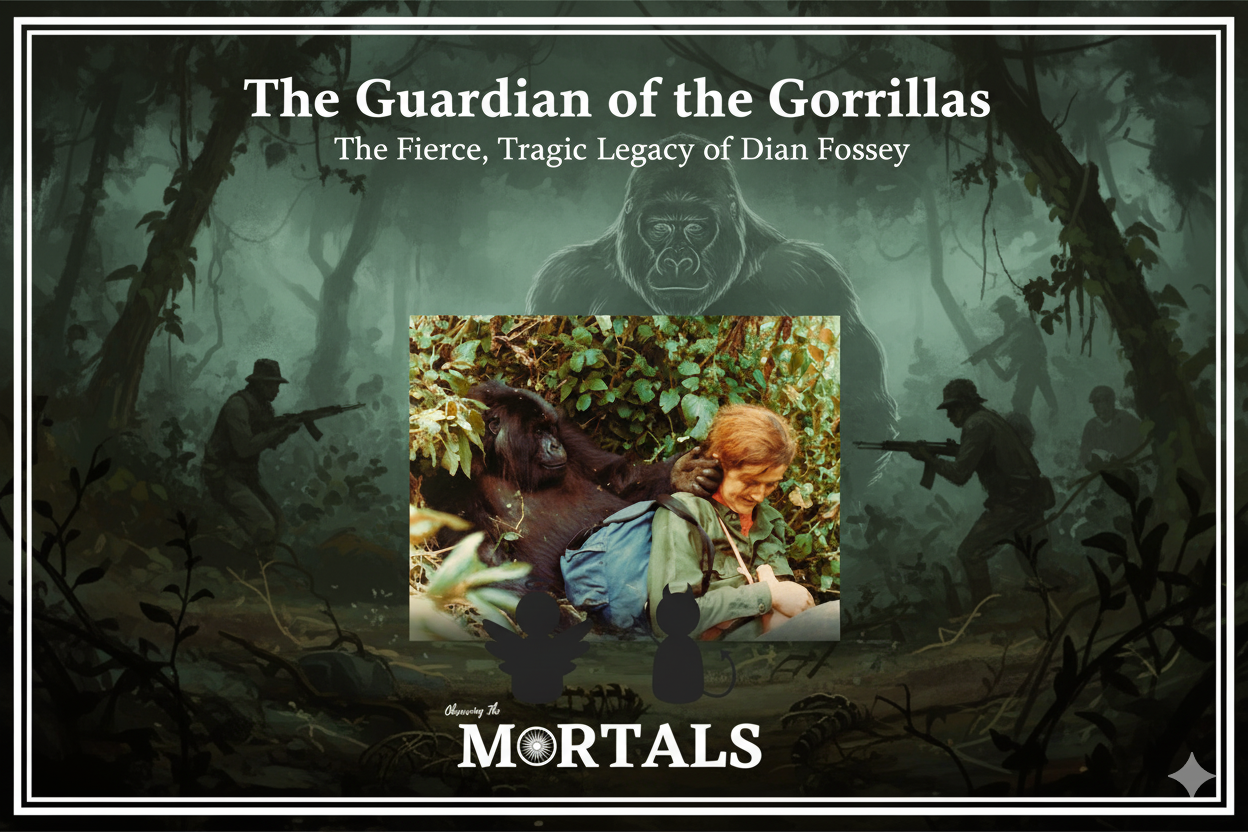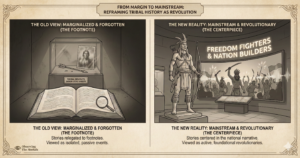Jane Goodall was not alone in her quest. She was the first of a legendary trio of female primatologists, often called “Leakey’s Angels” or the “Trimates,” sent by paleoanthropologist Louis Leakey to study the great apes in their natural habitats. The second was a fiercely determined American named Dian Fossey, who took on the formidable task of studying the mysterious and feared mountain gorillas of Rwanda. While Goodall became a global ambassador of hope, Fossey’s journey took a different, darker turn. This case study explores the life and work of a pioneer whose profound love for her subjects led her down a path of groundbreaking science, fierce advocacy, intense conflict, and ultimately, tragedy.
The Information Box
Syllabus Connection:
- Paper 1: Chapter 1.5 (Primate Behaviour: Gorillas), Chapter 1.4 (Human Evolution), Chapter 1.8 (Fieldwork Traditions)
Key Concepts/Tags:
- Dian Fossey, Gorillas in the Mist, Primatology, Mountain Gorillas, Conservation, The Trimates, Digit
The Setting: Who, What, Where?
This is the story of Dian Fossey, an American primatologist whose life was immortalized in her 1983 book, Gorillas in the Mist. Her journey took her to the mist-shrouded Virunga Mountains of Rwanda, a region plagued by political instability and poaching. There, in 1967, she established the Karisoke Research Center, which would become her home and the world’s most important site for the study of the endangered mountain gorilla. Her research continued there until her unsolved murder in 1985.
The Core Argument: Why Her Work Was Foundational
Fossey’s work not only created a new field of study but also single-handedly saved a species from the brink of extinction.
- Demystifying the “Monster”: Before Fossey, the Western world’s image of the gorilla was the monstrous, chest-thumping “King Kong.” Through thousands of hours of patient, quiet observation, Fossey was the first to reveal their true nature. She showed them to be shy, peaceful, and highly social “gentle giants” living in stable, close-knit family groups led by a commanding but protective silverback. Her work completely overturned their terrifying public image.
- Pioneering Fieldwork and Habituation: Like Goodall, Fossey pioneered methods of habituation, slowly earning the gorillas’ trust by mimicking their sounds and behaviors. She eventually achieved an unprecedented level of acceptance, allowing her to observe their intimate lives up close. Her detailed data on gorilla vocalizations, diet, social hierarchies, and emotional bonds were foundational to all future gorilla research. The story of her personal bond with a young silverback she named Digit became world-famous.
- The Birth of “Active Conservation”: This is where Fossey’s path diverged dramatically from Goodall’s. Faced with the constant, brutal reality of poachers killing “her” gorillas (including Digit, whose beheading and dismemberment devastated her), Fossey moved beyond just research. She became a practitioner of what she called “active conservation.” This was not about writing letters or giving speeches; it was about directly confronting poachers, destroying their traps and snares, and fighting a personal, often aggressive, war on the ground to protect the animals.
The Anthropologist’s Gaze: A Critical Perspective
Fossey’s uncompromising methods and tragic end have made her a subject of intense critical analysis.
- The Ethics of “Active Conservation”: Fossey’s confrontational approach was highly controversial. She was often accused of being a misanthrope who valued gorilla lives far more than human lives. Her tactics alienated many local people and government officials, raising a critical question that still dominates conservation today: can long-term conservation succeed by creating enemies, or must it be based on community partnership and providing local people with economic alternatives to poaching?
- The Perils of Habituation: While her habituation methods provided priceless scientific data, they also carry a risk. Gorillas that lose their natural fear of humans can become easier targets for poachers or more vulnerable to human diseases. This remains a central ethical dilemma for primatologists and conservationists.
- A Cautionary Tale: Her unsolved murder in 1985, widely believed to be a revenge killing by the poachers she fought, serves as a tragic cautionary tale. It highlights the immense personal risks of conservation work in areas of poverty and political instability, and the brutal consequences that can befall those who directly challenge powerful illegal networks.
The Exam Angle: How to Use This in Your Mains Answer
- Types of Questions Where It can be Used:
- “Discuss the behavior and characteristics of the great apes, focusing on gorillas.”
- “Compare the contributions and methodologies of different primatologists.”
- “Analyze the ethical dilemmas and different approaches in the field of conservation.”
- Model Integration:
- On Primate Behavior: “The study of the great apes provides crucial insights into social behavior. Dian Fossey’s long-term work with mountain gorillas, for instance, fundamentally overturned the ‘King Kong’ myth, revealing them to be gentle giants living in stable, cohesive family groups led by a dominant silverback.”
- On Conservation: “The ethics of conservation are complex, as shown by the legacy of Dian Fossey. Her ‘active conservation’ approach in Rwanda, which involved directly confronting poachers, was effective in saving gorillas in the short term but also alienated local communities, highlighting the ongoing debate between confrontational and community-based conservation strategies.”
- To show comparative knowledge: “Alongside Jane Goodall’s work on chimpanzee society, Dian Fossey’s research on gorillas was foundational. Both pioneers used immersive fieldwork to reveal the deep social complexity of the great apes, though Fossey’s legacy is uniquely defined by her controversial ‘active conservation’ methods and her tragic, violent death in the line of duty.”
Observer’s Take
Dian Fossey’s story is one of fierce, uncompromising, and ultimately tragic passion. She went to the misty mountains of Rwanda to study gorillas and ended up giving her life to save them. While her confrontational methods remain a subject of debate, her contribution is undeniable. She single-handedly changed the world’s perception of these magnificent animals and, through her relentless fight, almost certainly pulled them back from the brink of extinction. Her legacy, like Jane Goodall’s, is a powerful testament to the impact a single individual’s dedication can have. But her story is also a darker, more cautionary tale about the brutal realities of conservation, and the terrible price that is sometimes paid by those who dare to stand guard over the wild.





